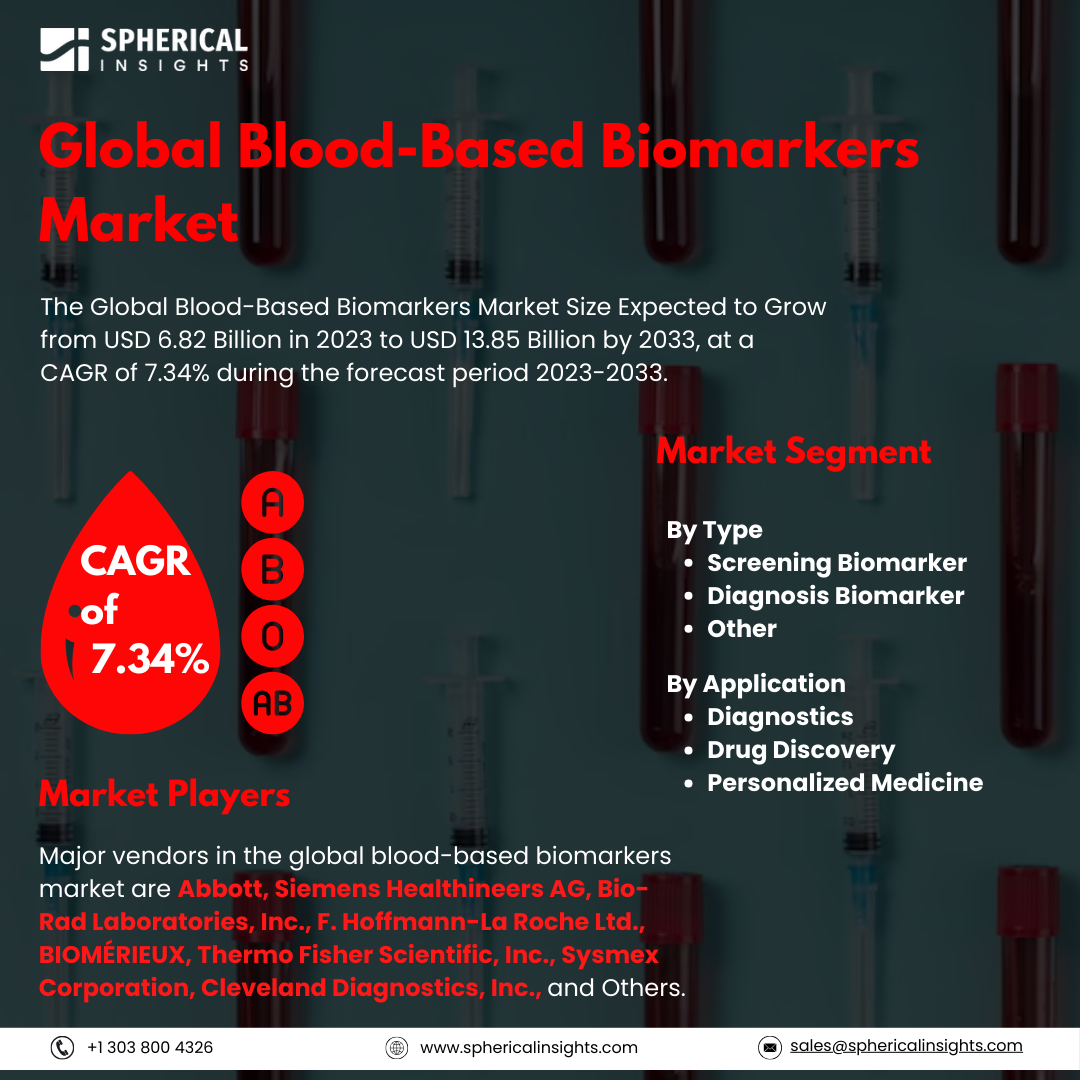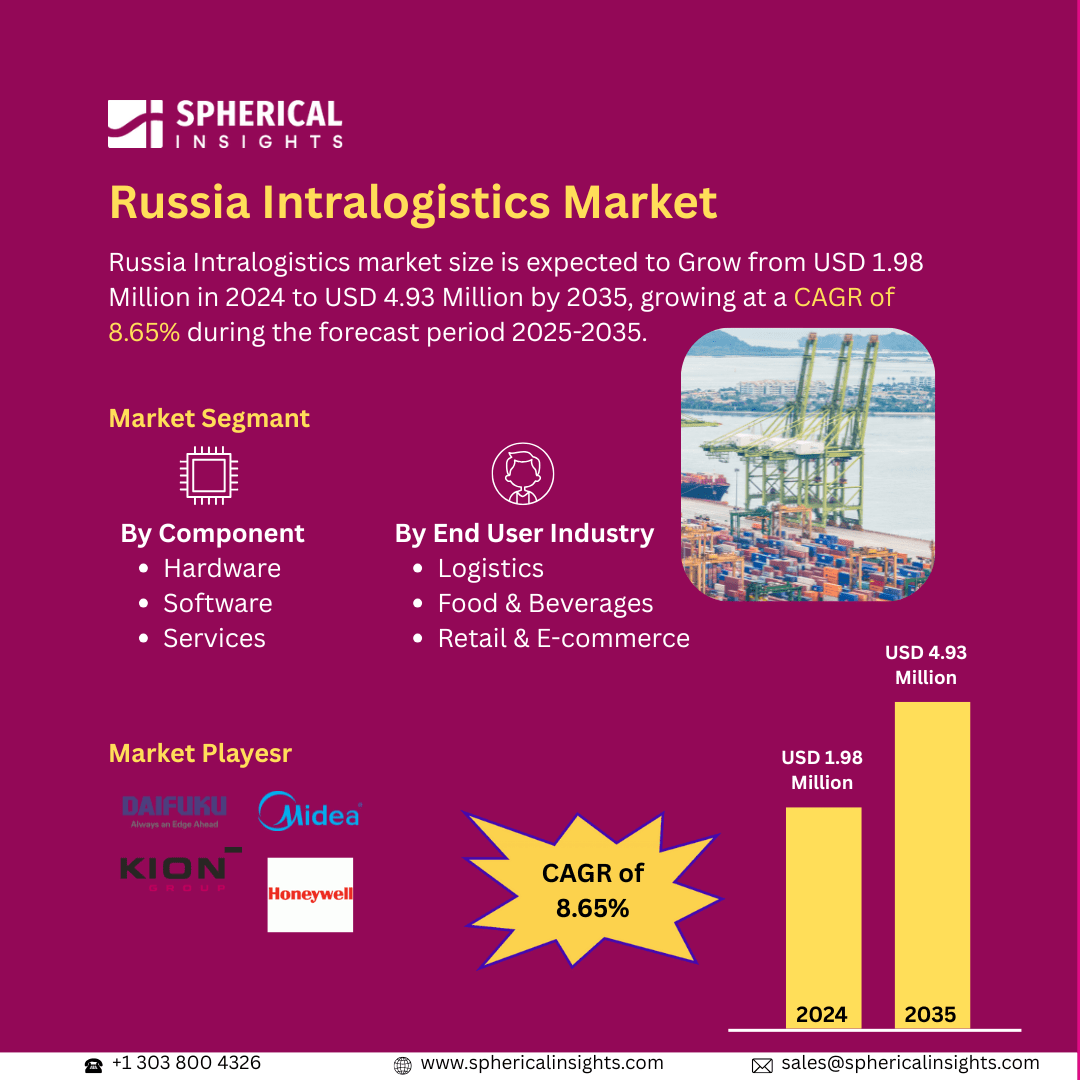Global Blood-Based Biomarkers Market Size To Exceed USD 13.85 Billion by 2033
According to a research report published by Spherical Insights & Consulting, The Global Blood-Based Biomarkers Market Size Expected to Grow from USD 6.82 Billion in 2023 to USD 13.85 Billion by 2033, at a CAGR of 7.34% during the forecast period 2023-2033.
Browse 210 market data Tables and 45 Figures spread through 190 Pages and in-depth TOC on the Global Blood-Based Biomarkers Market Size, Share, and COVID-19 Impact Analysis, By Type (Screening Biomarker, Diagnosis Biomarker, Other), By Application (Diagnostics, Drug Discovery, Personalized Medicine), and By Region (North America, Europe, Asia Pacific, Latin America, Middle East, and Africa), Analysis and Forecast 2023 – 2033.
The blood-based biomarkers market is the business engaged in the discovery, manufacture, and use of biomarkers present in blood to diagnose, predict, and monitor disease treatment. The biomarkers are proteins, nucleic acids, metabolites, and circulating tumor cells (CTCs) that provide non-invasive and real-time information on diseases, especially cancer, cardiovascular diseases, and neurological diseases. Moreover, the blood-based biomarkers market is propelled by increasing incidence of chronic conditions, especially cancer, cardiovascular, and neurodegenerative diseases, and the increasing need for early and non-invasive diagnostics. Technological advancements in liquid biopsy technologies, biomarker discovery, and precision medicine also contribute to market growth. Moreover, rising R&D spending, government support, and widening applications in drug development and disease monitoring drive adoption. However, high development costs of biomarkers, strict regulatory standards, and biomarker validation variability limit market growth. Limited standardization, reproducibility of data, and the requirement for specialized skills also impede widespread adoption.
The diagnosis biomarker segment accounted for the largest share of the global blood-based biomarkers market in 2023 and is anticipated to grow at a significant CAGR during the forecast period.
On the basis of type, the global blood-based biomarkers market is divided into screening biomarker, diagnosis biomarker, and other. Among these, the diagnosis biomarker segment accounted for the largest share of the global blood-based biomarkers market in 2023 and is anticipated to grow at a significant CAGR during the forecast period. This is because of their important function in identifying diseases such as cancer, cardiovascular disease, and neurological disorders. The increased need for early and precise diagnosis, improvements in biomarker-based assays, and higher clinical practice adoption further fuel their market dominance.
The diagnostics segment accounted for a substantial share of the global blood-based biomarkers market in 2023 and is anticipated to grow at a rapid pace during the projected period.
On the basis of the application, the global blood-based biomarkers market is divided into diagnostics, drug discovery, and personalized medicine. Among these, the diagnostics segment accounted for a substantial share of the global blood-based biomarkers market in 2023 and is anticipated to grow at a rapid pace during the projected period. This is owing to its extensive application in the early detection of disease, tracking disease progression, and treatment decision-making. The growing incidence of chronic diseases, developments in biomarker-based diagnostic tests, and the rising use of liquid biopsies also help in its market leadership.
North America is projected to hold the largest share of the global blood-based biomarkers market over the projected period.
North America is projected to hold the largest share of the global blood-based biomarkers market over the projected period. This is because of its well-developed healthcare system, high incidence of chronic diseases, and significant R&D expenditure. Increased presence of major market players, sophisticated biomarker technologies, and rising adoption of precision medicine also propel market growth in the region.
Asia Pacific is expected to grow at the fastest CAGR of the global blood-based biomarkers market during the projected period. This growth is attributable to rising investments in healthcare, rising incidence of chronic disorders, and mounting demand for early diagnosis. Expanding research in biotechnology, government initiatives towards precision medicine, and implementation of liquid biopsy technologies further boost market growth in nations such as China, India, and Japan.
Company Profiling
Major vendors in the global blood-based biomarkers market are Abbott, Siemens Healthineers AG, Bio-Rad Laboratories, Inc., F. Hoffmann-La Roche Ltd., BIOMÉRIEUX, Thermo Fisher Scientific, Inc., Sysmex Corporation, Cleveland Diagnostics, Inc., and Others.
Key Target Audience
- Market Players
- Investors
- End-users
- Government Authorities
- Consulting and Research Firm
- Venture capitalists
- Value-Added Resellers (VARs)
Recent Development
- In January 2025, Quanterix Corporation announced a merger deal to acquire Akoya Biosciences, bringing their capabilities together to develop the first end-to-end solution for ultra-sensitive detection of blood- and tissue-based protein biomarkers. The merger will speed up biomarker translation, enhance customer relationships, and provide substantial cost synergies.
Market Segment
This study forecasts revenue at global, regional, and country levels from 2023 to 2033. Spherical Insights has segmented the global blood-based biomarkers market based on the below-mentioned segments:
Global Blood-Based Biomarkers Market, By Type
- Screening Biomarker
- Diagnosis Biomarker
- Other
Global Blood-Based Biomarkers Market, By Application
- Diagnostics
- Drug Discovery
- Personalized Medicine
Global Blood-Based Biomarkers Market, By Regional
- North America
- Europe
- Germany
- UK
- France
- Italy
- Spain
- Russia
- Rest of Europe
- Asia Pacific
- China
- Japan
- India
- South Korea
- Australia
- Rest of Asia Pacific
- South America
- Brazil
- Argentina
- Rest of South America
- Middle East & Africa
- UAE
- Saudi Arabia
- Qatar
- South Africa
- Rest of the Middle East & Africa



